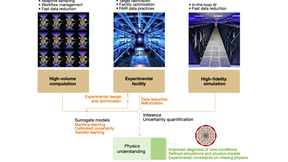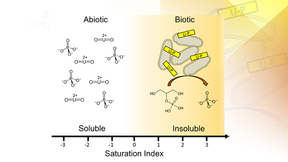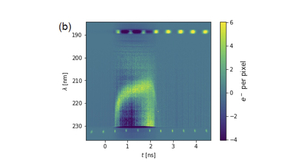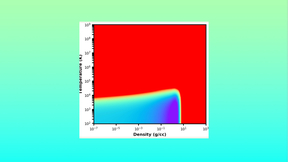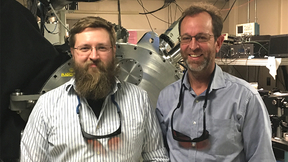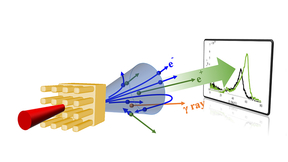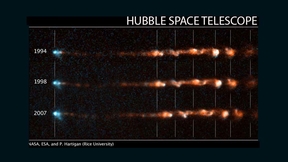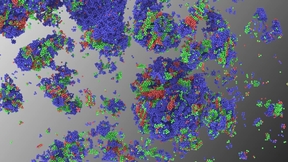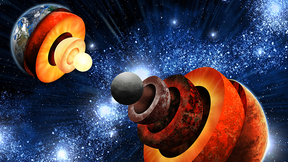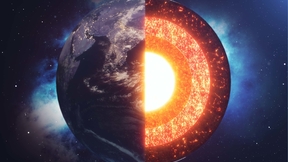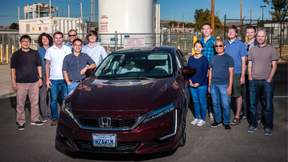Back
By applying modern machine learning and data science methods to “extreme” plasma physics, researchers can gain insight into our universe and find clues about creating a limitless amount of energy. In a recent perspective published in Nature, Lawrence Livermore National Laboratory (LLNL) scientists and international collaborators outline key challenges and future directions…
Imagine a bottle of salad dressing containing oil and vinegar. The oil has a lower density than vinegar, so it floats on the vinegar. The oil will not stay trapped under the vinegar if the bottle is flipped upside down. It will bubble up through the vinegar until a stable state is restored. This simple physical process is known as Rayleigh–Taylor instability, and it can be…
Uranium contamination of soils and groundwater in the United States represents a significant health risk and will require multiple remediation approaches. Remediation strategies for uranium-contaminated sites have been the focus of research for decades due to the former production of nuclear materials across the United States. The U.S. Environmental Protection Agency (EPA)…
In inertial confinement fusion (ICF) experiments at the National Ignition Facility (NIF), a spherical shell of deuterium-tritium fuel is imploded in an attempt to reach the conditions needed for fusion, self-heating and eventual ignition. Since theory and simulations indicate that ignition efficacy in one-dimension (1D) improves with increasing imploded fuel convergence…
“Sterile neutrinos” are theoretically predicted new particles that offer an intriguing possibility in the quest for understanding the dark matter in our universe. Unlike the known “active” neutrinos in the Standard Model (SM) of particle physics, these sterile neutrinos do not interact with normal matter as they move through space, making them very difficult to detect. A…
A team of scientists have conducted an analysis of directly driven gold sphere experiments to test heat transport models used in inertial confinement fusion (ICF) and high energy density (HED) modeling. It was found that overly restricting the heat flux caused disagreement with measurement. However, simulations with a reduced nonlocal heat transport model quantitatively…
Beryllium is a lightweight, low-density material used in a wide range of applications that require stability at high temperatures and pressures. Because of beryllium’s favorable traits, it has been considered as a potential capsule material for inertial confinement fusion (ICF) applications. Hydrodynamic simulations of ICF are frequently used to model the capsule behavior…
In a paper recently published by Scientific Reports, a team of scientists from Lawrence Livermore National Laboratory (LLNL) describes a high-precision interferometer system, newly developed to measure the pressure dependence of the refractive index and its dispersion in diamond anvil cells (DACs). “Accurately measuring the index of a compressed sample in DACs is a…
For the first time, researchers have isolated in a controlled laboratory setting the effects of the plasma geometry in its X-ray emission spectrum – the energy distribution of the radiation the plasmas emit. The work also is the first experimental testbed of the theories describing a phenomenon known in astrophysics as resonant scattering. This phenomenon is found in a…
Before the COVID-19 pandemic, HPCAT, a Chicago-based research consortium to advance high-pressure science in multidisciplinary fields using synchrotron radiation, hosted as many as 750 experimentalists each year—including numerous Lawrence Livermore National Laboratory (LLNL) teams. The consortium operates Sector 16 at the Advanced Photon Source (APS) at Argonne National…
Lawrence Livermore National Laboratory (LLNL) scientists recently published the results of a three-week experimental campaign at the Lab’s Jupiter Laser Facility to test the performance of laser-heated additive manufactured foams. The project helps support two major Laboratory focus areas, including helping to advance additive manufacturing and by enabling improvements in…
Lawrence Livermore National Laboratory (LLNL) scientists have achieved a near 100 percent increase in the amount of antimatter created in the laboratory. Using targets with micro-structures on the laser interface, the team shot a high-intensity laser through them and saw a 100 percent increase in the amount of antimatter (also known as positrons). The research appears in…
What are the next world-class, game-changing concepts and technologies that will address the most important questions in astrophysics or planetary science? Lawrence Livermore National Laboratory (LLNL) researchers will soon be better equipped to answer this question with the launch this month of a new Space Science Institute (SSI), intended to boost cross-discipline…
Outflows of matter are general features stemming from systems powered by compact objects such as black holes, active galactic nuclei, pulsar wind nebulae, accreting objects such as Young Stellar Objects (YSO) and mature stars such as our sun. But the shape of those outflows, or astrophysical jets, vary depending on the magnetic field around them. In new experiments, a…
Since the dawn of civilization, metallurgy has determined the fate of powerful cities, states and empires. Blacksmiths have harnessed the power of heat to melt simple metals that would then be cast into hard, sharp and shiny alloys. Varying process conditions, such as rate of cooling and composition, can lead to new materials with dramatically different mechanical…
Advances in astronomical observations have resulted in the discovery of an extraordinary number of extrasolar planets, some of which are believed to have a rocky composition similar to Earth. Learning more about their interior structure could provide important clues about their potential habitability. Led by Lawrence Livermore National Laboratory (LLNL), a team of…
Temperature is tough to measure, especially in shock compression experiments. A big challenge is having to account for thermal transport — the flow of energy in the form of heat. To better understand this challenge, researchers from Lawrence Livermore National Laboratory (LLNL) have taken important steps to show that thermal conduction is important and measurable at high…
DOE’s Hydrogen and Fuel Cell Technology Office (HFTO) selected Brandon Wood and Tadashi Ogitsu (both MSD) for the 2020 Technical Program Area Award in Hydrogen Fuel R&D. This award recognizes the computational materials science team at LLNL for their exceptional support to the HydroGEN Advanced Water Splitting Materials and Hydrogen Materials Advanced Research…
Carbon is one of the most ubiquitous elements in existence. As the fourth most abundant element in the universe, a building block for all known life and a material that sits in the interior of carbon-rich exoplanets, the element has been subject to intense investigation by scientists. Decades of studies have shown that carbon’s crystal structure has a significant impact on…
The first-ever shot to study a high explosive sample was recently conducted at the National Ignition Facility (NIF), the world’s most energetic laser. The results from the shot included novel data that will help researchers unlock the mysteries of high-explosive (HE) chemistry and position Lawrence Livermore National Laboratory (LLNL) to continue its legacy as a leader in…

